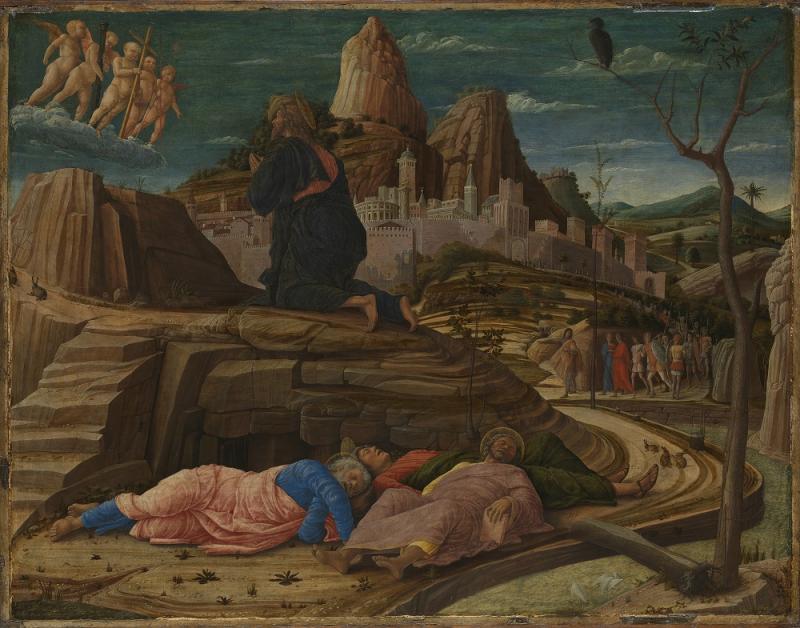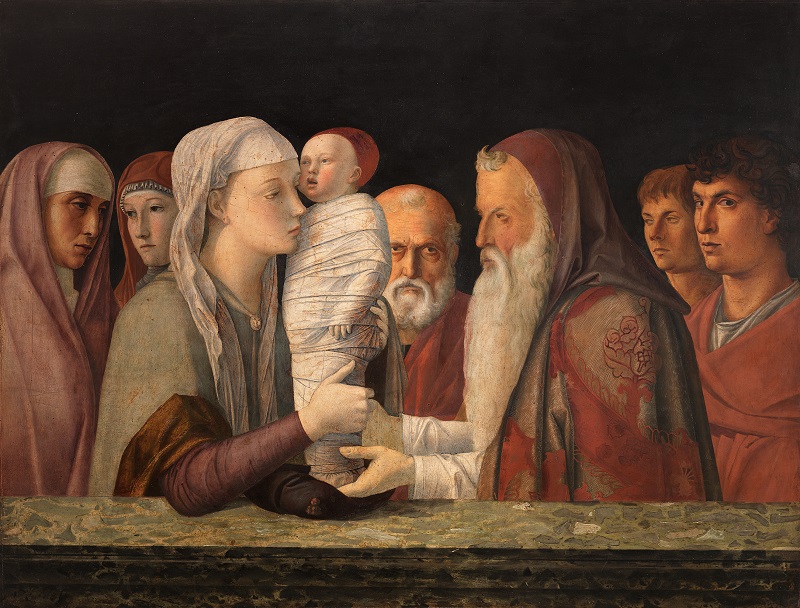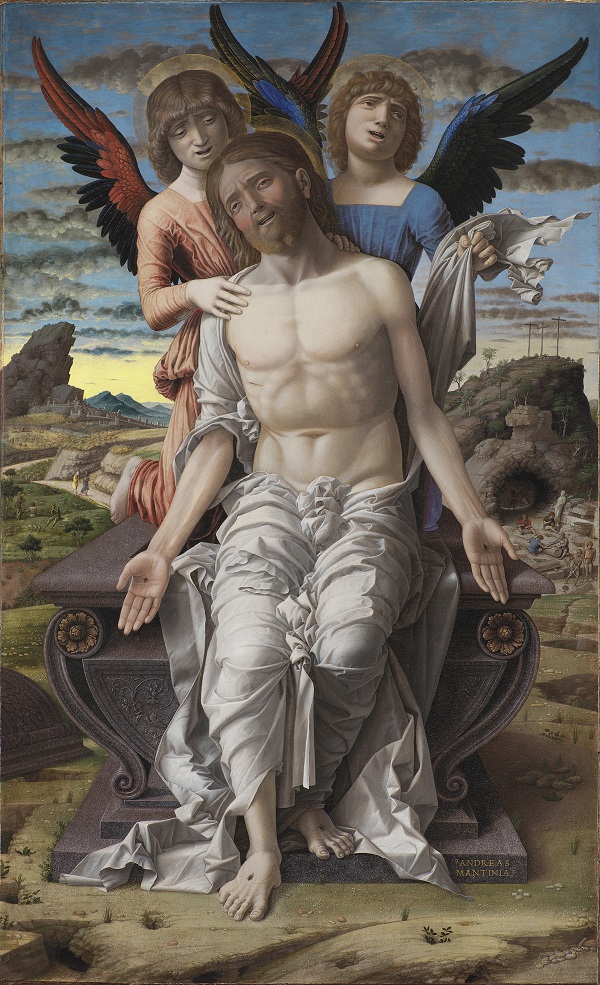Mantegna and Bellini, National Gallery review - curated for curators | reviews, news & interviews
Mantegna and Bellini, National Gallery review - curated for curators
Mantegna and Bellini, National Gallery review - curated for curators
An intriguing tale undone by loose ends

Pitched as “a tale of two artists”, the National Gallery’s big autumn show promises a history woven in shades of friendship and rivalry, marriage and family, privilege and hard graft.
By the ends of their lives, both men had achieved widespread acclaim, Mantegna at the court of Mantua’s ruling Gonzaga family, and Bellini in the service of the Venetian state. Following Mantegna’s marriage to Nicolosia, the two artists worked as closely as they ever would, and the opening rooms of this exhibition suggest Mantegna’s self-confidence and prodigious talent, as vividly as they struggle to identify Giovanni Bellini, an artist born in the shadow of his father. An early example of Mantegna’s work, Saint Mark the Evangelist, about 1448, shows him already honing his abilities as an illusionist, an architectural setting intensifying and personalising the encounter between viewer and saint, while demonstrating a knack for visual trickery that elevates the image beyond its relatively simple composition. But where is Bellini? Perhaps his hand is there in the Crucifixion by his father, Jacopo. Perhaps the delicate, almost ghostly pen and ink drawing, The Three Crosses, about 1456-7, was made by him. The first we really know of him here is his Presentation of Christ in the Temple, about 1470 (Pictured above). Except it’s not his. Giovanni traced Mantegna’s painting of this subject to make a copy, which he added to for reasons that are not entirely clear, diminishing it in the process.
But where is Bellini? Perhaps his hand is there in the Crucifixion by his father, Jacopo. Perhaps the delicate, almost ghostly pen and ink drawing, The Three Crosses, about 1456-7, was made by him. The first we really know of him here is his Presentation of Christ in the Temple, about 1470 (Pictured above). Except it’s not his. Giovanni traced Mantegna’s painting of this subject to make a copy, which he added to for reasons that are not entirely clear, diminishing it in the process.
Giovanni Bellini was cowed, one senses, by the overwhelming pressure of expectation that comes with esteemed parentage, Mantegna’s raw talent providing a refreshing and liberating contrast to the exacting example of Giovanni’s father. We see Bellini emulating his brother-in-law’s visual trickery in the foreshortened figure of Saint Peter, in his Agony in the Garden of about 1458-60, and his Descent of Christ into Limbo, about 1475-80, is closely modelled on Mantegna’s development of the theme, which introduces dramatic tension into earlier explorations by Jacopo Bellini from the 1450s. Mantegna’s chief innovation, taken up by Bellini, was to show the figure of Christ from behind, a compositional device that builds tension through concealment, demanding emotional engagement from the viewer.
It’s easy to lose sight of Bellini in all of this. Where Mantegna’s Agony in the Garden (Main picture) agitates us with the menace of imminent brutality, Bellini, literally, takes a step back. The soldiers are relegated to the middle distance, the figure of Christ in prayer elevated to a position of serene isolation. Where Mantegna hounds us with searing reminders of Christ’s humanity, Bellini uses an expansive landscape to impart an atmosphere of spiritual equilibrium, and the promise of salvation.
 Over their lifetimes, Bellini would prove to be as much of an influence on Mantegna – Bellini’s skill at using landscape to both evoke and amplify atmosphere and human emotion something that Mantegna emulates very noticeably in his Dead Christ Supported by Two Angels, about 1485-1500 (Pictured right), in which a carefully observed new dawn is used with obvious symbolism. By the end of his life, Mantegna’s drawings have an elegance and refinement more easily comparable to Bellini’s hand, than his own in previous decades.
Over their lifetimes, Bellini would prove to be as much of an influence on Mantegna – Bellini’s skill at using landscape to both evoke and amplify atmosphere and human emotion something that Mantegna emulates very noticeably in his Dead Christ Supported by Two Angels, about 1485-1500 (Pictured right), in which a carefully observed new dawn is used with obvious symbolism. By the end of his life, Mantegna’s drawings have an elegance and refinement more easily comparable to Bellini’s hand, than his own in previous decades.
But if the presence of drawings allows for broad observations about each artist’s evolving style, the preponderence of graphic works in this show is as problematic as it is welcome. The curators point out that in their youth, when Bellini was particularly in thrall to Mantegna, their hands are difficult to distinguish from one another, and drawings now attributed to Bellini have previously been given to Mantegna. The comparisons we are asked to make rely on painstaking scrutiny of the drawings, something that even a willing visitor will undoubtedly find hard to do, given the crowded viewing conditions that are to be expected.
Indeed the emphasis on drawing is somewhat hard to fathom, when so much can be said through their paintings, which highlight the points of similarity between the two no less than the differences. In fact, given the intense reciprocity that seems to have existed between the two, the differences between them are made all the more intriguing, none more so than their preferred media. While Bellini took to oil paint, Mantegna would continue to paint in the traditional medium of egg tempera. It barely gets a mention in the show, though you can read about it in the catalogue.
rating
Explore topics
Share this article
The future of Arts Journalism
You can stop theartsdesk.com closing!
We urgently need financing to survive. Our fundraising drive has thus far raised £49,000 but we need to reach £100,000 or we will be forced to close. Please contribute here: https://gofund.me/c3f6033d
And if you can forward this information to anyone who might assist, we’d be grateful.

Subscribe to theartsdesk.com
Thank you for continuing to read our work on theartsdesk.com. For unlimited access to every article in its entirety, including our archive of more than 15,000 pieces, we're asking for £5 per month or £40 per year. We feel it's a very good deal, and hope you do too.
To take a subscription now simply click here.
And if you're looking for that extra gift for a friend or family member, why not treat them to a theartsdesk.com gift subscription?
more Visual arts
 'We are bowled over!' Thank you for your messages of love and support
Much-appreciated words of commendation from readers and the cultural community
'We are bowled over!' Thank you for your messages of love and support
Much-appreciated words of commendation from readers and the cultural community
 Folkestone Triennial 2025 - landscape, seascape, art lovers' escape
Locally rooted festival brings home many but not all global concerns
Folkestone Triennial 2025 - landscape, seascape, art lovers' escape
Locally rooted festival brings home many but not all global concerns
 Sir Brian Clarke (1953-2025) - a personal tribute
Remembering an artist with a gift for the transcendent
Sir Brian Clarke (1953-2025) - a personal tribute
Remembering an artist with a gift for the transcendent
 Emily Kam Kngwarray, Tate Modern review - glimpses of another world
Pictures that are an affirmation of belonging
Emily Kam Kngwarray, Tate Modern review - glimpses of another world
Pictures that are an affirmation of belonging
 Kiefer / Van Gogh, Royal Academy review - a pairing of opposites
Small scale intensity meets large scale melodrama
Kiefer / Van Gogh, Royal Academy review - a pairing of opposites
Small scale intensity meets large scale melodrama
 Jenny Saville: The Anatomy of Painting, National Portrait Gallery review - a protégé losing her way
A brilliant painter in search of a worthwhile subject
Jenny Saville: The Anatomy of Painting, National Portrait Gallery review - a protégé losing her way
A brilliant painter in search of a worthwhile subject
 Abstract Erotic, Courtauld Gallery review - sculpture that is sensuous, funny and subversive
Testing the boundaries of good taste, and winning
Abstract Erotic, Courtauld Gallery review - sculpture that is sensuous, funny and subversive
Testing the boundaries of good taste, and winning
 Edward Burra, Tate Britain review - watercolour made mainstream
Social satire with a nasty bite
Edward Burra, Tate Britain review - watercolour made mainstream
Social satire with a nasty bite
 Ithell Colquhoun, Tate Britain review - revelations of a weird and wonderful world
Emanations from the unconscious
Ithell Colquhoun, Tate Britain review - revelations of a weird and wonderful world
Emanations from the unconscious
 Rachel Jones: Gated Canyons, Dulwich Picture Gallery review - teeth with a real bite
Mouths have never looked so good
Rachel Jones: Gated Canyons, Dulwich Picture Gallery review - teeth with a real bite
Mouths have never looked so good
 Yoshitomo Nara, Hayward Gallery review - sickeningly cute kids
How to make millions out of kitsch
Yoshitomo Nara, Hayward Gallery review - sickeningly cute kids
How to make millions out of kitsch
 Hamad Butt: Apprehensions, Whitechapel Gallery review - cool, calm and potentially lethal
The YBA who didn’t have time to become a household name
Hamad Butt: Apprehensions, Whitechapel Gallery review - cool, calm and potentially lethal
The YBA who didn’t have time to become a household name
